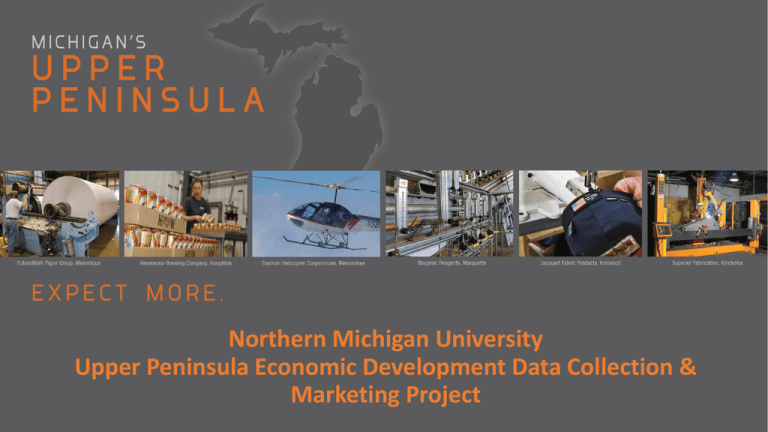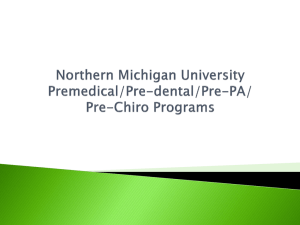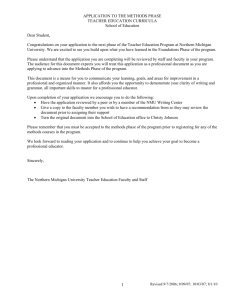Presentation from Innovate Michigan! Summit 2014
advertisement

Northern Michigan University Upper Peninsula Economic Development Data Collection & Marketing Project Innovate Michigan! Summit Thursday, September 4, 2014 Presenters: Jennifer James-Mesloh, Ph.D. Margot Rusinek, City Manager of Wakefield, Michigan • Economic development data collection and marketing project • Community Partnerships: • Upper Peninsula Collaborative Development Council (UPCDC) • Lake Superior Community Partnership (LSCP) • Determined business attraction and marketing need intense emphasis within the 15 Upper Peninsula (UP) counties • Business attraction and marketing are capital and time-intensive • LSCP was charged with the regional-wide effort • Creation of digital and hardcopy material aligned with the International Economic Development Council’s (IEDC) site selection data standards • Site-selection data standards • Multiple tables contain over 1,200 data elements organized into 25 spreadsheets • Spreadsheets contain data national site-selection consultants use when considering a new area for business • MPA students collected data on 11 of the 25 spreadsheets • Remaining data was collected by another research team • Need existed for customized marketing pieces for UP counties • Target site selectors and bring additional business entities to their area • Minimal staff resources to compile needed information • Research partnership with graduate students in the masters of public administration program at NMU • Graduate students enrolled in PS 545: Community Development in fall semester 2013 and PS 595: Rural Community Development in winter semester 2014 • Gathered information on 14 counties within the UP of Michigan Marquette County was excluded from this project since the LSCP was tasked with compiling that data • IEDC spreadsheets were organized into table format and labeled A-K for each reference and used Microsoft Excel as the data collection software • To maintain the data, students uploaded their information into NMUs – online EduCat • Information being collected was accessible through public records. No confidentiality concerns or threats to human subjects • Once spreadsheets were completed, NMU faculty, Jennifer James-Mesloh, Ph.D., collapsed the data to create a composite public asset database for the Upper Peninsula of Michigan • Data collection September – December 2013 • 15 students - Community Development • Each student in the course was assigned a county • Three students assigned two counties • 50 hours student work time per county • Data collection January – May 2014 • 16 students - Rural Community Development • Students were grouped into teams and assigned one or more counties • Faculty/ students traveled to and met with economic developers each UP county from March – June 2014 • • • • 25 hours data review 5-8 hours travel & meeting with EDCs 5 hours revisions Approximately 85 hours of student working time per UP county over a two semester time-frame Total student time: 1,190 hours • Reports • Data Collection • Data tables were created for each UP county • Presentations to UP Counties • March – June 2014 students and faculty traveled to each UP county • Webinar Presentation of Data • Tuesday, April 29, 2014, 10:00 – 11:00 a.m. • Webpage Development: https://www.nmu.edu/education/node/208 • Lessons learned from this project fall into two categories: • Organizational Capacity • Storing and Dissemination of Public Information • Part-time or volunteer staffing • 3 – 10 hours per week • Government by volunteer • Access to office resources • Phones • Use of U.S. mail versus Email • Internet access • Office space outside personal residence • Access to office resources • Economic development offices offices open only 3 – 5 hours per week • Staff prioritized responses to communications resulting in 3+ months for replies following repeated attempts • Many data points collected were based on personal communication with staff who either worked for government or economic development offices • Data gleaned from collective memory • Documentation of data from personal communication not available • Type of public information disseminated varies widely on government websites • Measure of success from a community-partnership is how it influences students that participated • Margot Rusinek and Troy Louis, participated in this project and were able to translate their experiences and skill sets into tangible outcomes • Need that became know was greater enhancement and assistance with disseminating community-based information via city and county websites • Startling discovery – many city and county governments in the UP do not an official websites owned, supported and maintained by them • Challenge in determining validity when data gathered since several websites were being hosted on behalf of a government entity by a non-profit or other interested community party • Validity and reliability of public information being disseminated by outside entities on behalf of UP governments • Example of “government by volunteer” • Learning by doing • Shift in all courses in the MPA program at NMU to include ASL • This project has served as the hallmark for all other courses • • • • • • Alger – Kathy Reynolds Baraga – Jeff Ratcliffe Chippewa – Jeff Hagan Delta – Vicki Schwab Dickinson – Bruce Ortenburger Gogebic – Michael Brown, Kim Corcoran, Margot Rusinek, Velda Sclafani • Houghton – Jeff Ratcliffe • Keweenaw – Jeff Ratcliffe • • • • Iron – Julie Melchiori Luce – Carmen Pittenger Mackinac – Jeff Hagan, Anne Ottaway Marquette – Amy Clickner, Alex Knudson, Derek Bush, Denise Elizondo • Menominee – Nancy Douglas • Schoolcraft – Paul Garber • Ontonagon – Velda Sclafani, Sue Priess, Tom Poisson, Pat Tucker, Carl Nykanen, Stacy Priess For more information contact: Northern Michigan University Master’s of Public Administration Program Jennifer James-Mesloh, M.P.A., Ph.D. Assistant Professor & MPA Program Coordinator jjamesme@nmu.edu (906) 227-1858











